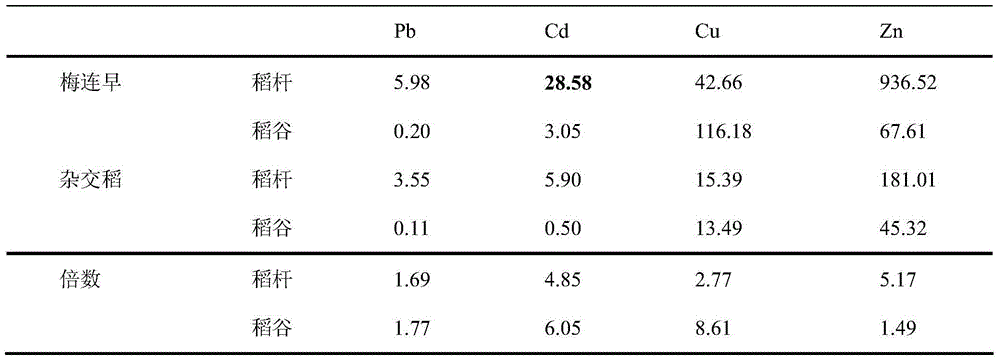Phytoremediation method for restoring farmland soil heavy metal cadmium pollution
A phytoremediation and heavy metal technology, applied in the restoration of polluted soil, etc., can solve the problems of polluted soil characteristics and climate, unsuitability, lack of agricultural management, etc., achieve simple and easy planting technology, reduce cadmium content, and restore soil. Effects of heavy metal cadmium pollution
- Summary
- Abstract
- Description
- Claims
- Application Information
AI Technical Summary
Problems solved by technology
Method used
Image
Examples
Embodiment 1
[0015] Taking the farmland of Shangba Village, Xinjiang Town, Wengyuan County, Shaoguan City, Guangdong Province as a pilot, the farmland of this village has been irrigated with river water polluted by tailings water from the Dabaoshan mining area for a long time, and the heavy metal cadmium in the soil generally exceeds the standard. The content is 0.498mg / kg (the national standard is cd ≤ 0.3mg / kg). In 2009, the late rice was planted with Mei Lianzao. It was managed routinely and combined with draining and sunning from the booting stage to the milk maturity stage. After harvest, the rice straw and rice were analyzed Cadmium content, the results show that the cadmium content of rice straw is as high as 28.58mg / kg, and the cadmium content of rice is 3.05mg / kg. Compared with conventional hybrid rice, the cadmium content of rice straw is 4.85 times that of hybrid rice, and 6.05 times that of rice (see Table 1) . The biomass of rice straw is 500 kg / mu, and that of rice is 400 kg / ...
Embodiment 2
[0020] In 2013, it was built in Pengzhou, Sichuan for the demonstration of the application of Mei Lian Zao. The heavy metal cadmium content in the planting soil was 0.60mg / kg. Investigate the biomass of roots, stems and rice and measure the cadmium content respectively. The results show that the average cadmium content in roots is 0.7786mg / kg, the cadmium content in stems is 0.4466mg / kg, and the cadmium content in rice is 3.15mg / kg. Combined calculation of biomass, it can be obtained that 115.64mg / mu of cadmium can be taken away by rice root, 615.81mg / mu of cadmium by rice straw, and 1417.5mg / mu of cadmium can be taken away by rice. 2148.95mg / mu, the cadmium concentration in the soil plow layer can be reduced by 0.017mg / kg. After planting, the cadmium content in the soil is 0.58mg / kg, which is basically consistent with the cadmium taken away by Mei Lianzao.
PUM
 Login to View More
Login to View More Abstract
Description
Claims
Application Information
 Login to View More
Login to View More - R&D
- Intellectual Property
- Life Sciences
- Materials
- Tech Scout
- Unparalleled Data Quality
- Higher Quality Content
- 60% Fewer Hallucinations
Browse by: Latest US Patents, China's latest patents, Technical Efficacy Thesaurus, Application Domain, Technology Topic, Popular Technical Reports.
© 2025 PatSnap. All rights reserved.Legal|Privacy policy|Modern Slavery Act Transparency Statement|Sitemap|About US| Contact US: help@patsnap.com

